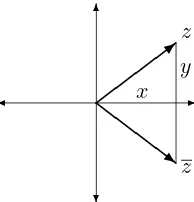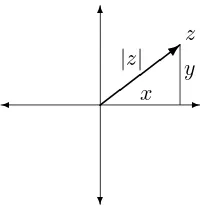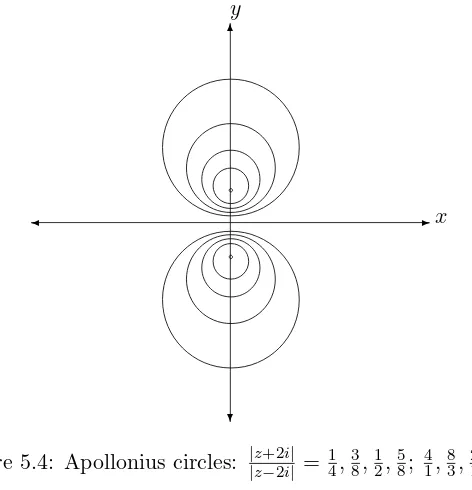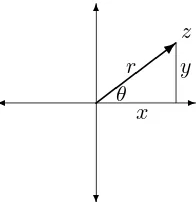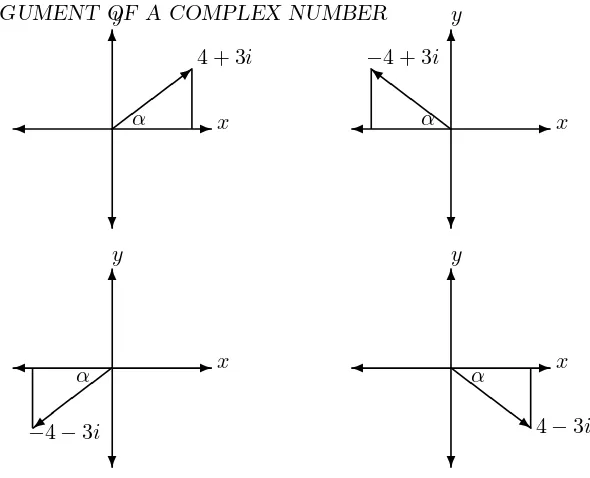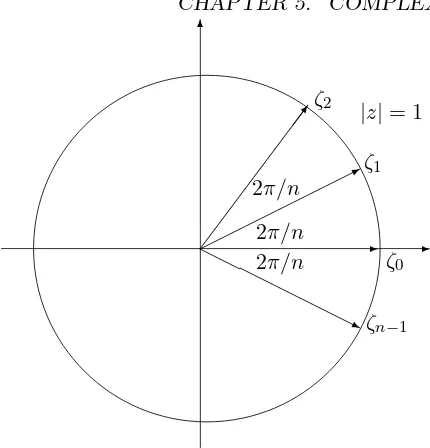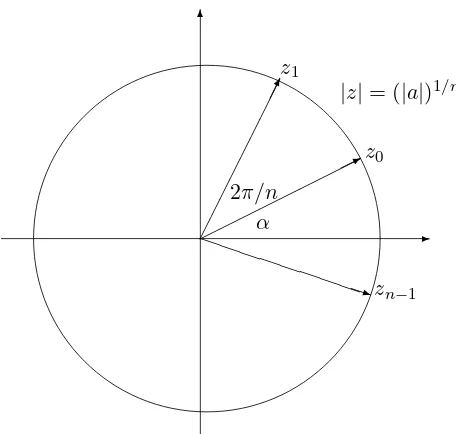Chapter 5
COMPLEX NUMBERS
5.1
Constructing the complex numbers
One way of introducing the fieldCof complex numbers is via the arithmetic
of 2×2 matrices.
DEFINITION 5.1.1 A complex number is a matrix of the form
x −y y x
,
wherex and y are real numbers.
Complex numbers of the form
x 0
0 x
are scalar matrices and are called
real complex numbers and are denoted by the symbol{x}.
The real complex numbers {x} and {y} are respectively called thereal partand imaginary partof the complex number
is denoted by the symboli.
We have the identities
Complex numbers of the formi{y}, wherey is a non–zero real number, are calledimaginary numbers.
If two complex numbers are equal, we can equate their real and imaginary parts:
{x1}+i{y1}={x2}+i{y2} ⇒x1 =x2 and y1 =y2,
ifx1, x2, y1, y2 are real numbers. Noting that {0}+i{0} ={0}, gives the
useful special case is
{x}+i{y}={0} ⇒x= 0 and y= 0,
ifx andy are real numbers.
The sum and product of two real complex numbers are also real complex numbers:
{x}+{y}={x+y}, {x}{y}={xy}.
Also, as real complex numbers are scalar matrices, their arithmetic is very simple. They form a field under the operations of matrix addition and multiplication. The additive identity is {0}, the additive inverse of {x} is
{−x}, the multiplicative identity is{1}and the multiplicative inverse of{x}
is{x−1}. Consequently
{x} − {y}={x}+ (−{y}) ={x}+{−y}={x−y},
{x}
{y} ={x}{y}
−1 =
{x}{y−1}={xy−1}=
x y
.
It is customary to blur the distinction between the real complex number
{x} and the real numberx and write {x} asx. Thus we write the complex number{x}+i{y} simply as x+iy.
More generally, the sum of two complex numbers is a complex number:
(x1+iy1) + (x2+iy2) = (x1+x2) +i(y1+y2); (5.1)
and (using the fact that scalar matrices commute with all matrices under matrix multiplication and {−1}A = −A if A is a matrix), the product of two complex numbers is a complex number:
(x1+iy1)(x2+iy2) =x1(x2+iy2) + (iy1)(x2+iy2)
=x1x2+x1(iy2) + (iy1)x2+ (iy1)(iy2)
=x1x2+ix1y2+iy1x2+i2y1y2
= (x1x2+{−1}y1y2) +i(x1y2+y1x2)
5.2. CALCULATING WITH COMPLEX NUMBERS 91
The set C of complex numbers forms a field under the operations of
matrix addition and multiplication. The additive identity is 0, the additive inverse of x+iy is the complex number (−x) +i(−y), the multiplicative identity is 1 and the multiplicative inverse of the non–zero complex number
x+iy is the complex numberu+iv, where
u= x
x2+y2 and v=
−y x2+y2.
(Ifx+iy6= 0, thenx6= 0 ory6= 0, so x2+y2 6= 0.)
From equations 5.1 and 5.2, we observe that addition and multiplication of complex numbers is performed just as for real numbers, replacing i2 by
−1, whenever it occurs.
A useful identity satisfied by complex numbers is
r2+s2 = (r+is)(r−is).
This leads to a method of expressing the ratio of two complex numbers in the form x+iy, where xand y are real complex numbers.
x1+iy1
x2+iy2
= (x1+iy1)(x2−iy2) (x2+iy2)(x2−iy2)
= (x1x2+y1y2) +i(−x1y2+y1x2)
x2 2+y22
.
The process is known asrationalization of the denominator.
5.2
Calculating with complex numbers
We can now do all the standard linear algebra calculations over the field of complex numbers – find the reduced row–echelon form of an matrix whose el-ements are complex numbers, solve systems of linear equations, find inverses and calculate determinants.
For example, solve the system
(1 +i)z+ (2−i)w = 2 + 7i
7z+ (8−2i)w = 4−9i.
The coefficient determinant is
1 +i 2−i
7 8−2i
= (1 +i)(8−2i)−7(2−i)
= (8−2i) +i(8−2i)−14 + 7i
Hence by Cramer’s rule, there is a unique solution:
z =
2 + 7i 2−i
4−9i 8−2i
−4 + 13i
= (2 + 7i)(8−2i)−(4−9i)(2−i)
−4 + 13i
= 2(8−2i) + (7i)(8−2i)− {(4(2−i)−9i(2−i)}
−4 + 13i
= 16−4i+ 56i−14i
2− {8−4i−18i+ 9i2}
−4 + 13i
= 31 + 74i
−4 + 13i
= (31 + 74i)(−4−13i) (−4)2+ 132
= 838−699i (−4)2+ 132
= 838
185− 699 185i
and similarly w= −698
185 +
229 185i.
An important property enjoyed by complex numbers is that every com-plex number has a square root:
THEOREM 5.2.1
If w is a non–zero complex number, then the equation z2 = w has a so-lutionz∈C.
Proof. Let w=a+ib, a, b∈R.
Case 1. Suppose b = 0. Then if a > 0, z = √a is a solution, while if
a <0,i√−a is a solution.
Case 2. Suppose b 6= 0. Let z = x+iy, x, y ∈ R. Then the equation
z2 =w becomes
(x+iy)2=x2−y2+ 2xyi=a+ib,
so equating real and imaginary parts gives
5.2. CALCULATING WITH COMPLEX NUMBERS 93
so equating real and imaginary parts gives
x2−y2= 1 and 2xy = 1. Hence the solutions are
EXAMPLE 5.2.2 Solve the equation z2+ (√3 +i)z+ 1 = 0.
Solution. Because every complex number has a square root, the familiar formula
z= −b±
√
b2−4ac
2a
for the solution of the general quadratic equation az2+bz+c = 0 can be
used, where nowa(6= 0), b, c∈C. Hence
z = −(
√
3 +i)± q
(√3 +i)2−4
2
= −(
√
3 +i)± q
(3 + 2√3i−1)−4 2
= −(
√
3 +i)±p−2 + 2√3i
2 .
Now we have to solve w2 = −2 + 2√3i. Put w = x+iy. Then w2 =
x2 −y2 + 2xyi = −2 + 2√3i and equating real and imaginary parts gives
x2−y2=−2 and 2xy= 2√3. Hence y=√3/xand so x2−3/x2=−2. So
x4+ 2x2−3 = 0 and (x2+ 3)(x2−1) = 0. Hence x2−1 = 0 and x =±1. Then y=±√3. Hence (1 +√3i)2 =−2 + 2√3iand the formula for z now becomes
z = −
√
3−i±(1 +√3i) 2
= 1−
√
3 + (1 +√3)i
2 or
−1−√3−(1 +√3)i
2 .
EXAMPLE 5.2.3 Find the cube roots of 1.
Solution. We have to solve the equation z3 = 1, or z3 −1 = 0. Now
z3−1 = (z−1)(z2+z+ 1). Soz3−1 = 0⇒z−1 = 0 or z2+z+ 1 = 0. But
z2+z+ 1 = 0⇒z= −1±
√
12−4
2 =
−1±√3i
2 .
So there are 3 cube roots of 1, namely 1 and (−1±√3i)/2.
5.3. GEOMETRIC REPRESENTATION OFC 95
THEOREM 5.2.2 (Gauss) Iff(z) =anzn+an−1zn−1+· · ·+a1z+a0,
wherean6= 0 andn≥1, then f(z) = 0 for some z∈C.
It follows that in view of thefactor theorem, which states that if a∈ F is a root of a polynomial f(z) with coefficients from a fieldF, thenz−ais a factor off(z), that isf(z) = (z−a)g(z), where the coefficients of g(z) also belong to F. By repeated application of this result, we can factorize any polynomial with complex coefficients into a product of linear factors with complex coefficients:
f(z) =an(z−z1)(z−z2)· · ·(z−zn).
There are available a number of computational algorithms for finding good approximations to the roots of a polynomial with complex coefficients.
5.3
Geometric representation of
C
Complex numbers can be represented as points in the plane, using the cor-respondence x+iy ↔ (x, y). The representation is known as the Argand diagram or complex plane. The real complex numbers lie on the x–axis, which is then called the real axis, while the imaginary numbers lie on the
y–axis, which is known as the imaginary axis. The complex numbers with positive imaginary part lie in theupper half plane, while those with negative imaginary part lie in thelower half plane.
Because of the equation
(x1+iy1) + (x2+iy2) = (x1+x2) +i(y1+y2),
complex numbers add vectorially, using the parallellogram law. Similarly, the complex numberz1−z2 can be represented by the vector from (x2, y2)
to (x1, y1), wherez1 =x1+iy1 andz2 =x2+iy2. (See Figure 5.1.)
The geometrical representation of complex numbers can be very useful when complex number methods are used to investigate properties of triangles and circles. It is very important in the branch of calculus known as Complex Function theory, where geometric methods play an important role.
We mention that the line through two distinct pointsP1= (x1, y1) and
P2 = (x2, y2) has the form z = (1−t)z1+tz2, t ∈ R, where z =x+iy is
any point on the line andzi =xi+iyi, i= 1,2. For the line has parametric
equations
x= (1−t)x1+tx2, y= (1−t)y1+ty2
✲ ✛
✻
❄ z1−z2
z1+z2
z1
z2
✒
✟✟✟✟
✟✟✟✟ ✯
✁✁ ✁✁
✁✁ ✁✁✕
❅ ❅
❅ ❅ ❘
❅ ❅
❅ ❅ ❘ ✟✟✟✟
✟✟✟✟
✁✁ ✁✁
✁✁ ✁✁
Figure 5.1: Complex addition and subraction.
Circles have various equation representations in terms of complex num-bers, as will be seen later.
5.4
Complex conjugate
DEFINITION 5.4.1 (Complex conjugate) If z= x+iy, the complex conjugateofz is the complex number defined byz=x−iy. Geometrically, the complex conjugate of z is obtained by reflecting z in the real axis (see Figure 5.2).
The following properties of the complex conjugate are easy to verify:
1. z1+z2 =z1+z2;
2. −z=−z.
3. z1−z2 =z1−z2;
4. z1z2 =z1z2;
5. (1/z) = 1/z;
5.4. COMPLEX CONJUGATE 97
✲ ✛
✻
❄
x y z
z
✚✚ ✚✚❃ ❩
❩ ❩
❩ ⑦
Figure 5.2: The complex conjugate of z: z.
7. zis real if and only ifz=z;
8. With the standard convention that the real and imaginary parts are denoted by Rez and Imz, we have
Rez= z+z
2 , Imz=
z−z
2i ;
9. Ifz=x+iy, thenzz=x2+y2.
THEOREM 5.4.1 If f(z) is a polynomial with real coefficients, then its non–real roots occur in complex–conjugate pairs, i.e. if f(z) = 0, then
f(z) = 0.
Proof. Suppose f(z) = anzn+an−1zn−1 +· · ·+a1z +a0 = 0, where
an, . . . , a0 are real. Then
0 = 0 =f(z) = anzn+an−1zn−1+· · ·+a1z+a0
= anzn+a
n−1zn−1+· · ·+a1z+a0
= anzn+an−1zn−1+· · ·+a1z+a0
= f(z).
EXAMPLE 5.4.1 Discuss the position of the roots of the equation
z4 =−1
in the complex plane.
clearly no real roots and no imaginary roots. So there must be one root w
in the first quadrant, with all remaining roots being given by w,−w and
−w. In fact, as we shall soon see, the roots lie evenly spaced on the unit circle.
The following theorem is useful in deciding if a polynomial f(z) has a multiple roota; that is if (z−a)m dividesf(z) for somem≥2. (The proof
is left as an exercise.)
THEOREM 5.4.2 If f(z) = (z−a)mg(z), where m ≥ 2 and g(z) is a polynomial, then f′(a) = 0 and the polynomial and its derivative have a common root.
From theorem 5.4.1 we obtain a result which is very useful in the explicit integration of rational functions (i.e. ratios of polynomials) with real coeffi-cients.
THEOREM 5.4.3 If f(z) is a non–constant polynomial with real coeffi-cients, then f(z) can be factorized as a product of real linear factors and real quadratic factors.
Proof. In general f(z) will have r real roots z1, . . . , zr and 2s non–real
roots zr+1, zr+1, . . . , zr+s, zr+s, occurring in complex–conjugate pairs by
theorem 5.4.1. Then if an is the coefficient of highest degree in f(z), we
have the factorization
f(z) = an(z−z1)· · ·(z−zr)×
×(z−zr+1)(z−zr+1)· · ·(z−zr+s)(z−zr+s).
We then use the following identity for j = r+ 1, . . . , r+s which in turn shows that paired terms give rise to real quadratic factors:
(z−zj)(z−zj) = z2−(zj +zj)z+zjzj
= z2−2Rezj+ (x2j+y2j),
wherezj =xj +iyj.
A well–known example of such a factorization is the following:
5.5. MODULUS OF A COMPLEX NUMBER 99
✲ ✛
✻
❄ |z|
x y z
✚✚ ✚✚❃
Figure 5.3: The modulus of z:|z|.
Solution. Clearly there are no real roots. Also we have the preliminary factorization z4 + 1 = (z2−i)(z2+i). Now the roots of z2 −i are easily
verified to be ±(1 +i)/√2, so the roots of z2 +i must be ±(1−i)/√2.
In other words the roots are w = (1 +i)/√2 and w, −w,−w. Grouping conjugate–complex terms gives the factorization
z4+ 1 = (z−w)(z−w)(z+w)(z+w)
= (z2−2zRew+ww)(z2+ 2zRew+ww) = (z2−√2z+ 1)(z2+√2z+ 1).
5.5
Modulus of a complex number
DEFINITION 5.5.1 (Modulus) If z = x+iy, the modulus of z is the non–negative real number|z|defined by|z|=px2+y2. Geometrically, the
modulus ofz is the distance fromz to 0 (see Figure 5.3).
More generally,|z1−z2|is the distance betweenz1 andz2 in the complex
plane. For
|z1−z2|=|(x1+iy1)−(x2+iy2)| = |(x1−x2) +i(y1−y2)|
= p(x1−x2)2+ (y1−y2)2.
The following properties of the modulus are easy to verify, using the identity
|z|2 =zz:
(i) |z1z2|=|z1||z2|;
(iii)
For example, to prove (i):
|z1z2|2 = (z1z2)z1z2 = (z1z2)z1z2
THEOREM 5.5.1 (Ratio formulae) Ifzlies on the line throughz1and
z2:
z= (1−t)z1+tz2, t∈R,
we have the useful ratio formulae:
(i)
0, represents the circle centre z0 and radius r. For example the equation
|z−(1 + 2i)|= 3 represents the circle (x−1)2+ (y−2)2 = 9.
Another useful circle equation is thecircle of Apollonius :
whereaandbare distinct complex numbers andλis a positive real number,
5.5. MODULUS OF A COMPLEX NUMBER 101
Figure 5.4: Apollonius circles: |z+2i| |z−2i| =
1
4,38,12,58; 41,83,21,85.
An algebraic proof that the above equation represents a circle, runs as follows. We use the following identities:
(i) |z−a|2 = |z|2−2Re (za) +|a|2
Now it is easily verified that
So we obtain
The last equation represents a circle centrez0, radiusr, where
z0 =
a−λ2b
1−λ2 and r=
λ|a−b|
|1−λ2|.
There are two special points on the circle of Apollonius, the points z1 and
z2 defined by
It is easy to verify thatz1 and z2 are distinct points on the line througha
andband thatz0= z1+z2 2. Hence the circle of Apollonius is the circle based
on the segmentz1, z2 as diameter.
EXAMPLE 5.5.2 Find the centre and radius of the circle
|z−1−i|= 2|z−5−2i|.
Solution. Method 1. Proceed algebraically and simplify the equation
|x+iy−1−i|= 2|x+iy−5−2i|
or
|x−1 +i(y−1)|= 2|x−5 +i(y−2)|.
Squaring both sides gives
(x−1)2+ (y−1)2 = 4((x−5)2+ (y−2)2),
which reduces to the circle equation
x2+y2−38
3 x− 14
3 y+ 38 = 0. Completing the square gives
5.6. ARGUMENT OF A COMPLEX NUMBER 103
Method 2. Calculate the diametrical points z1 and z2 defined above by
equations 5.3:
and the radiusr is given by
r=|z1−z0|=
5.6
Argument of a complex number
Let z=x+iy be a non–zero complex number, r =|z|=px2+y2. Then
we have x = rcosθ, y = rsinθ, where θ is the angle made by z with the positivex–axis. Soθ is unique up to addition of a multiple of 2π radians.
DEFINITION 5.6.1 (Argument) Any number θ satisfying the above pair of equations is called an argument of z and is denoted by argz. The particular argument ofzlying in the range−π < θ≤πis called theprincipal argumentof z and is denoted by Argz (see Figure 5.5).
EXAMPLE 5.6.1 Arg 1 = 0, Arg (−1) =π, Argi= 2π, Arg (−i) =−π2.
We note thaty/x = tanθ ifx 6= 0, soθ is determined by this equation up to a multiple ofπ. In fact
Argz= tan−1 y
x +kπ,
wherek= 0 if x >0; k= 1 if x <0, y >0; k=−1 if x <0, y <0.
To determine Argzgraphically, it is simplest to draw the triangle formed by the points 0, x, z on the complex plane, mark in the positive acute angle
α between the rays 0, x and 0, z and determine Argz geometrically, using the fact that α= tan−1(|y|/|x|), as in the following examples:
EXAMPLE 5.6.2 Determine the principal argument ofz for the followig complex numbers:
z= 4 + 3i, −4 + 3i, −4−3i, 4−3i.
Solution. Referring to Figure 5.6, we see that Argz has the values
α, π−α, −π+α, −α,
whereα= tan−1 3 4.
An important property of the argument of a complex number states that the sum of the arguments of two non–zero complex numbers is an argument of their product:
THEOREM 5.6.1 If θ1 and θ2 are arguments ofz1 and z2, thenθ1+θ2
is an argument ofz1z2.
Proof. Let z1 and z2 have polar representations z1 = r1(cosθ1+isinθ1)
and z2 =r2(cosθ2+isinθ2). Then
z1z2 = r1(cosθ1+isinθ1)r2(cosθ2+isinθ2)
= r1r2(cosθ1cosθ2−sinθ1sinθ2+i(cosθ1sinθ2+ sinθ1cosθ2))
= r1r2(cos (θ1+θ2) +isin (θ1+θ2)),
which is the polar representation ofz1z2, as r1r2 =|z1||z2|=|z1z2|. Hence
θ1+θ2 is an argument ofz1z2.
An easy induction gives the following generalization to a product of n
5.6. ARGUMENT OF A COMPLEX NUMBER 105
Figure 5.6: Argument examples.
COROLLARY 5.6.1 Ifθ1, . . . , θnare arguments forz1, . . . , znrespectively,
thenθ1+· · ·+θnis an argument for z1· · ·zn.
Takingθ1 =· · ·=θn=θin the previous corollary gives
COROLLARY 5.6.2 Ifθis an argument ofz, thennθ is an argument for
zn.
THEOREM 5.6.2 If θ is an argument of the non–zero complex number
In terms of principal arguments, we have the following equations: (i) Arg (z1z2) = Argz1+Argz2+ 2k1π,
(ii) Arg (z−1) = −Argz+ 2k2π,
(iii) Arg (z1/z2) = Argz1−Argz2+ 2k3π,
(iv) Arg (z1· · ·zn) = Argz1+· · ·+Argzn+ 2k4π,
(v) Arg (zn) = nArgz+ 2k5π,
wherek1, k2, k3, k4, k5 are integers.
In numerical examples, we can write (i), for example, as
Arg (z1z2)≡ Argz1+ Argz2.
EXAMPLE 5.6.3 Find the modulus and principal argument of
z=
√
3 +i
1 +i
!17
and hence expressz in modulus–argument form.
Solution. |z|= |
√
3 +i|17
|1 +i|17 =
217 (√2)17 = 2
17/2.
Argz ≡ 17Arg
√
3 +i
1 +i
!
= 17(Arg (√3 +i)−Arg (1 +i))
= 17π 6 −
π
4
= −17π 12 .
Hence Argz= −1217π
+ 2kπ, where kis an integer. We see that k= 1 and hence Argz= 7π12. Consequentlyz= 217/2 cos 7π
12 +isin 7π12
.
DEFINITION 5.6.2 Ifθ is a real number, then we defineeiθ by
eiθ = cosθ+isinθ.
More generally, ifz=x+iy, then we defineez by
ez =exeiy.
For example,
eiπ2 =i, eiπ =−1, e−
iπ
2 =−i.
The following properties of the complex exponential function are left as
5.7. DE MOIVRE’S THEOREM 107
THEOREM 5.6.3 (i) ez1ez2 = ez1+z2,
(ii) ez1· · ·ezn = ez1+···+zn,
(iii) ez 6= 0,
(iv) (ez)−1 = e−z, (v) ez1/ez2 = ez1−z2,
(vi) ez = ez.
THEOREM 5.6.4 The equation
ez = 1
has the complete solutionz= 2kπi, k ∈Z.
Proof. First we observe that
e2kπi= cos (2kπ) +isin (2kπ) = 1.
Conversely, supposeez = 1, z=x+iy. Then ex(cosy+isiny) = 1. Hence
excosy = 1 and exsiny = 0. Hence siny = 0 and so y =nπ, n∈Z. Then
excos (nπ) = 1, so ex(−1)n = 1, from which follows (−1)n = 1 as ex >0.
Hencen= 2k, k∈Z and ex = 1. Hence x= 0 andz= 2kπi.
5.7
De Moivre’s theorem
The next theorem has many uses and is a special case of theorem 5.6.3(ii). Alternatively it can be proved directly by induction onn.
THEOREM 5.7.1 (De Moivre) Ifnis a positive integer, then
(cosθ+isinθ)n= cos nθ+isin nθ.
As a first application, we consider the equationzn= 1.
THEOREM 5.7.2 The equationzn = 1 has n distinct solutions, namely
the complex numbers ζk = e
2kπi
n , k = 0,1, . . . , n−1. These lie equally
spaced on the unit circle|z|= 1 and are obtained by starting at 1, moving round the circle anti–clockwise, incrementing the argument in steps of 2πn. (See Figure 5.7)
✲ ✲
ζ0
ζ1
ζ2
ζn−1
✻
✓✓ ✓✓
✓✓ ✓✓✼
✟✟✟✟
✟✟✟✟ ✯
❍❍ ❍❍
❍❍ ❍❍❥
2π/n
2π/n
2π/n
|z|= 1
Figure 5.7: Thenth roots of unity.
Proof. With ζk defined as above,
ζkn=e2kπin
n
=e2kπin n= 1,
by De Moivre’s theorem. However |ζk|= 1 and argζk = 2kπn , so the
com-plex numbers ζk, k = 0,1, . . . , n−1, lie equally spaced on the unit circle.
Consequently these numbers must be precisely all the roots of zn−1. For the polynomial zn−1, being of degree n over a field, can have at most n
distinct roots in that field.
The more general equation zn=a, wherea∈,C,a6= 0, can be reduced
to the previous case:
Let α be argument of z, so that a= |a|eiα. Then if w =|a|1/neiαn, we
have
wn = |a|1/neiαn
n
= (|a|1/n)neiαn
n
= |a|eiα =a.
5.7. DE MOIVRE’S THEOREM 109
✲
z0
z1
zn−1
✻
PPP
PPPPPP q ✁✁
✁✁ ✁✁
✁✁✁✕
✟✟✟✟
✟✟✟✟ ✟ ✯
α
2π/n
|z|= (|a|)1/n
Figure 5.8: The roots ofzn=a.
e2kπin , k= 0,1, . . . , n−1, or
zk=|a|1/ne iα
ne
2kπi
n =|a|1/ne i(α+2kπ)
n , (5.4)
k= 0,1, . . . , n−1. So the roots are equally spaced on the circle
|z|=|a|1/n
and are generated from the special solution having argument equal to (arga)/n, by incrementing the argument in steps of 2π/n. (See Figure 5.8.)
EXAMPLE 5.7.1 Factorize the polynomial z5 −1 as a product of real linear and quadratic factors.
Solution. The roots are 1, e2πi5 , e−2
πi
5 , e4
πi
5 , e−4
πi
5 , using the fact that non–
real roots come in conjugate–complex pairs. Hence
z5−1 = (z−1)(z−e2πi5 )(z−e− 2πi
5 )(z−e 4πi
5 )(z−e−
4πi 5 ).
Now
(z−e2πi5 )(z−e− 2πi
5 ) = z2−z(e 2πi
5 +e− 2πi
5 ) + 1
Similarly
(z−e4πi5 )(z−e−4
πi
5 ) =z2−2zcos 4π
5 + 1.
This gives the desired factorization.
EXAMPLE 5.7.2 Solve z3 =i.
Solution. |i|= 1 and Argi= π2 =α. So by equation 5.4, the solutions are
zk=|i|1/3e i(α+2kπ)
3 , k= 0,1,2.
First,k= 0 gives
z0 =e iπ
6 = cos π
6 +isin
π
6 =
√
3
2 +
i
2.
Next,k= 1 gives
z1=e
5πi
6 = cos 5π
6 +isin 5π
6 =
−√3
2 +
i
2.
Finally, k= 2 gives
z1 =e
9πi
6 = cos 9π
6 +isin 9π
6 =−i.
We finish this chapter with two more examples of De Moivre’s theorem.
EXAMPLE 5.7.3 If
C = 1 + cosθ+· · ·+ cos (n−1)θ, S = sinθ+· · ·+ sin (n−1)θ,
prove that
C= sin
nθ 2
sin θ2 cos
(n−1)θ
2 and S=
sin nθ2 sin θ2 sin
(n−1)θ
2 ,
5.8. PROBLEMS 111
Solution.
C+iS = 1 + (cosθ+isinθ) +· · ·+ (cos (n−1)θ+isin (n−1)θ) = 1 +eiθ+· · ·+ei(n−1)θ
= 1 +z+· · ·+zn−1, where z=eiθ
= 1−z
n
1−z , ifz6= 1, i.e. θ6= 2kπ,
= 1−e
inθ
1−eiθ =
einθ2 (e−
inθ
2 −e
inθ
2 )
eiθ2(e−
iθ
2 −e
iθ
2)
= ei(n−1)θ2sin
nθ 2
sin θ2
= (cos (n−1)θ2 +isin (n−1)θ2)sin
nθ 2
sin θ2 .
The result follows by equating real and imaginary parts.
EXAMPLE 5.7.4 Express cosnθ and sinnθ in terms of cosθ and sinθ, using the equation cosnθ+ sinnθ = (cosθ+isinθ)n.
Solution. The binomial theorem gives
(cosθ+isinθ)n= cosnθ+ n1
cosn−1θ(isinθ) + n2
cosn−2θ(isinθ)2+· · ·
+ (isinθ)n.
Equating real and imaginary parts gives
cosnθ = cosnθ− n 2
cosn−2θsin2θ+· · ·
sin nθ= n1
cosn−1θsinθ− n 3
cosn−3θsin3θ+· · ·.
5.8
PROBLEMS
1. Express the following complex numbers in the formx+iy, x, y real:
(i) (−3 +i)(14−2i); (ii) 2 + 3i 1−4i; (iii)
(1 + 2i)2
1−i .
[Answers: (i)−40 + 20i; (ii)−1017+1711i; (iii) −72+ 2i.]
(i) iz+ (2−10i)z = 3z+ 2i,
(ii) (1 +i)z+ (2−i)w = −3i
(1 + 2i)z+ (3 +i)w = 2 + 2i.
[Answers:(i)z=−419 −41i ; (ii) z=−1 + 5i, w= 195 −8i5.]
3. Express 1 + (1 +i) + (1 +i)2+. . .+ (1 +i)99 in the form x+iy, x, y
real. [Answer: (1 + 250)i.]
4. Solve the equations: (i)z2=−8−6i; (ii)z2−(3 +i)z+ 4 + 3i= 0.
[Answers: (i)z=±(1−3i); (ii)z= 2−i, 1 + 2i.]
5. Find the modulus and principal argument of each of the following complex numbers:
(i) 4 +i; (ii)−32 −2i; (iii) −1 + 2i; (iv) 12(−1 +i√3).
[Answers: (i) √17, tan−1 14; (ii) √210,−π + tan−1 13; (iii) √5, π −
tan−12.]
6. Express the following complex numbers in modulus-argument form:
(i) z= (1 +i)(1 +i√3)(√3−i).
(ii) z= (1 +i)
5(1−i√3)5
(√3 +i)4 .
[Answers:
(i)z= 4√2(cos 5π12 +isin 5π12); (ii)z= 27/2(cos 11π12 +isin 11π12).]
7. (i) Ifz= 2(cos π4+isin π4) andw= 3(cos π6+isin π6), find the polar form of
(a)zw; (b) wz; (c) wz; (d) wz52.
(ii) Express the following complex numbers in the formx+iy:
(a) (1 +i)12; (b) 1√−i 2
−6 .
[Answers: (i): (a) 6(cos 5π12 +isin 5π12); (b) 23(cos 12π +isin 12π);
(c) 32(cos −12π +isin −12π); (d) 329 (cos 11π12 +isin 11π12);
5.8. PROBLEMS 113
8. Solve the equations:
(i) z2 = 1 +i√3; (ii)z4=i; (iii) z3 =−8i; (iv)z4 = 2−2i.
[Answers: (i) z = ±(√√3+i)
2 ; (ii) i k(cos π
8 +isin π8), k = 0,1,2,3; (iii)
z= 2i, −√3−i,√3−i; (iv) z=ik238(cos π
16−isin 16π), k= 0,1,2,3.]
9. Find the reduced row–echelon form of the complex matrix
2 +i −1 + 2i 2 1 +i −1 +i 1 1 + 2i −2 +i 1 +i
.
[Answer:
1 i 0
0 0 1 0 0 0
.]
10. (i) Prove that the line equationlx+my=nis equivalent to
pz+pz= 2n,
wherep=l+im.
(ii) Use (ii) to deduce that reflection in the straight line
pz+pz=n
is described by the equation
pw+pz=n.
[Hint: The complex numberl+imis perpendicular to the given line.]
(iii) Prove that the line|z−a|=|z−b|may be written aspz+pz=n, wherep=b−aand n=|b|2− |a|2. Deduce that ifz lies on the Apollonius circle ||zz−−ba|| =λ, thenw, the reflection ofzin the line
|z−a|=|z−b|, lies on the Apollonius circle |z−a| |z−b| =
1 λ.
11. Letaand bbe distinct complex numbers and 0< α < π.
Argz−a
z−b =α,−α, π−α, α−π.
Also show that Argz−a
z−b =πrepresents the line segment joining aand b, while Argz−a
z−b = 0 represents the remaining portion of
the line throughaand b.
(ii) Use (i) to prove that four distinct points z1, z2, z3, z4 are
con-cyclic or collinear, if and only if thecross–ratio
z4−z1
z4−z2
/z3−z1 z3−z2
is real.
(iii) Use (ii) to derivePtolemy’sTheorem: Four distinct pointsA, B, C, D
are concyclic or collinear, if and only if one of the following holds:
AB·CD+BC·AD = AC·BD BD·AC+AD·BC = AB·CD

